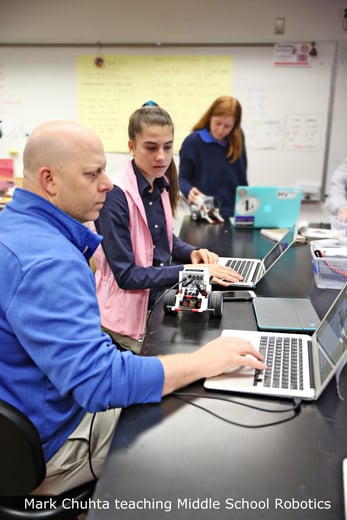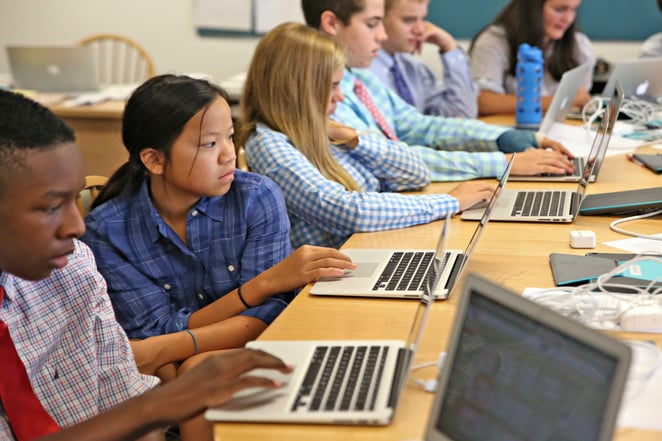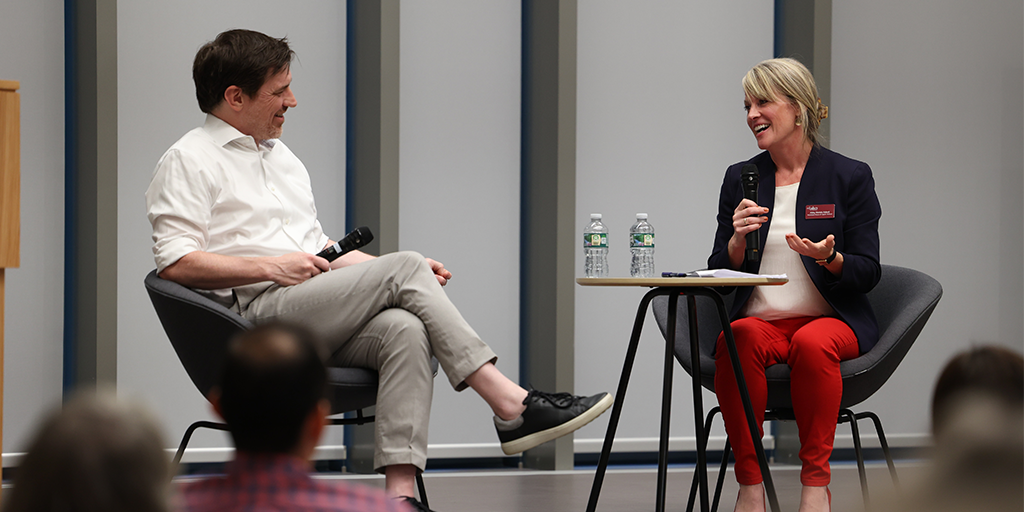OVERWHELMED BY DIGITAL PARENTING? THIS MAY MAKE IT EASIER...
As the first generation of parents raising digital natives, we can often feel overwhelmed and, quite honestly, clueless. As new or awkward situations occur with our children’s devices or their online presence, we make up a rule, revise an old rule, get frustrated, yell, and, let’s face it, accomplish little in helping our children set priorities and understand their digital footprints.
Like many parents, I bought each of my sons a cell phone when they entered 5th grade. I rationalized my decision. I wanted—no, I NEEDED—my kids to be able to communicate with us when they went off campus, even though they were fully supervised by my trusted colleagues and friends. As How to Raise an Adult author Julie Lythcott-Haims explained during her parenting workshop at St. Luke’s last fall, the birth of the internet, 24-hour news, and Amber Alerts caused Gen-X parents (like me) to be hypervigilant. I wish I was the exception to this anxiety-causing trend, but I am not.
Complicating matters is the fact that modern education has become increasingly technology dependent. It is almost impossible for my children to complete their homework without the internet. So now, in addition to a cell phone, my children have laptops and/or an iPad. My youngest has a cell phone and a laptop (that’s two devices), the middle child has a cell phone, an iPad, and a laptop (add three more devices), and my oldest has a cell phone, an iPad, and a laptop (and three more devices are added to the list). So, if you’re keeping score, that is a grand total of EIGHT devices I have to keep track of each day. It has become a second full-time job, just keeping track of my kids’ internet usage.
ESTABLISHING RULES (GOOD LUCK WITH THAT)

Over the years, I’ve tried every tactic to manage my sons’ usage: devices collected at 10pm, devices in your room but on the dresser, devices in your room and next to the bed to be used as an alarm clock, devices in your room and under your pillow so you can listen to “white noise” as you drift off to sleep, devices in your room and in your hand in case your lab partner needs to text or email you at any given moment...even if it’s 2am, etc.
Sound familiar? It seems as soon as we have a rule, our children have an abundance of reasons why we need to be more flexible and/or reasonable. Let’s face it, according to our children we “just don’t understand!” And sometimes, we don’t.
While I can understand the need for devices to be present during homework time (I give homework assignments that rely on the internet), the fact of the matter is, our house (and most houses) doesn’t become a quiet study hall from 6-10pm. My wife and I often go to bed BEFORE my kids are done with their homework. Things start spinning out of control when I create rules I have no possible way of enforcing. One thing is sure and true—what I was doing wasn’t working.
FIGHT FIRE WITH FIRE
It was a fellow parent who told me about a new product that seemed too good to be true. I never imagined that what I needed was more technology, but Disney’s Circle seemed to be the answer to my prayers. For only $99, “The Mouse” would easily manage my children’s digital life, regardless of the type of device. A quick setup has the Circle hooked to my home network, which in turn allows me to monitor my kids’ online activity and set time limits, internet “off times”, and bedtimes. About ten minutes after opening the box, I had the Circle up and running, and was customizing internet access for my three children's different needs.
Not everyone was as pleased as my wife and I. Our first interaction with our 11 year-old after installing the Circle was proof of that. When I was a kid, I spent my summers waking up early, going outside, and not coming home until I was hungry or it was dark (whichever came first). I wanted my 11 year-old to have the experiences that I had in the summer of 1980. I wanted him to be outside all day long, playing, getting dirty, and enjoying the warm weather. With that in mind, I had set his total internet access to 90 minutes a day. He woke up early, just like I wanted him to, but proceeded to blow through his daily internet allotment before 8am. Furious, he stormed into our room and let me know, in no uncertain terms, that this was unfair treatment, bordering on torturous. After listening to his tirade, my wife turned to me chuckling and quoted E.B. White’s Charlotte’s Web: “... You talk about controlling myself?...This is the most terrible case of injustice that I ever heard of!”
Use of the Circle led us to one of the most important components of any online monitoring tool. Establishing rules without first having a conversation, as the documentary Screenagers points out, will be seen as unfair by our children. With this knowledge in hand, my wife and I grabbed cups of coffee and took the opportunity to have individual conversations about internet access with our children (tailoring our talks for an 11-, 14-, and 18-year-old).
 |
| St. Luke's students at start-of-the-year technology rollout |
CIRCLING THE WAGONS AROUND THE CIRCLE
As I pointed out earlier, each of my children has a cell phone. With cell phones comes a data plan, and with a data plan comes the internet. Even though the Circle limited their access to home WiFi, they still had data on their phones and more temptation to go down the internet rabbit hole. I was right back to square one. How was I going to get their cell phones to play within this virtual sandbox?
Upon further research, I realized there were answers out there, and it was going to take a combination of products to accomplish my goals. Verizon’s Family Safeguards, AT&T’s Smart Limits, or T-Mobile’s Family Allowances are all fee-based programs designed to allow you to monitor certain aspects of your child’s cell phone, assign bedtimes, and limit their data usage. Additionally, even the Circle has a subscription-based program called Circle Go that will take all the current settings, filters, and time allotments you’ve created with the Circle and extend them to any network a device joins, including a cell’s data plan.
What I’ve come to realize is this: there is not a one-size-fits-all method of helping my children navigate their digital lives and maintain proper balance. For my family, the combination of the Circle and AT&T’s Smart Limits seems to be working. My kids get a certain amount of online time per day, and their WiFi and data shuts off at an agreed-upon bedtime. When exceptions are needed, we reopen and continue our conversation, always keeping moderation and priorities in mind.
While raising a digital native is a monumental task, it is not impossible. If we embrace the world our children are growing up in and work with it instead of fighting against it, we may be able to live together harmoniously. Luckily, there are people and companies in the technology field who are in our corner, working to lay out an easier path that we can walk together.
Get our latest blog posts!

By Author
- Amber Berry: Former Head of Middle School ( 2 )
- Beth Yavenditti: Director of Global Education ( 3 )
- Carrie Meatto: Spanish Teacher ( 1 )
- Daphne Teittinen-Schreck: ESS Director ( 1 )
- Dr. Jason Haynes: History Chair ( 2 )
- Dr. Stephanie Bramlett: Former Director of Inclusive Excellence ( 2 )
- Gareth Fancher: Director of Emotional Intelligence ( 1 )
- Georgia Rosenberg '19: Student ( 1 )
- Hunter Martin: Summer Program Director ( 1 )
- Jacqueline Nelson: Director of Equity and Inclusion ( 4 )
- Jane Olsen: Fifth Grade Teacher (retired) ( 1 )
- Jason Giffen: Director of Enrollment Management ( 4 )
- Jessie Samuel, Fifth Grade Science Teacher ( 1 )
- Jim Foley: Asst. Head of School for Leadership & Innovation ( 2 )
- Jim Yavenditti: Director of Studies ( 1 )
- Joshua Schneider, Upper School Science Teacher ( 1 )
- Julia Gabriele: Associate Head of School & Chief Financial Officer ( 5 )
- Kate Parker-Burgard: Director of Community Connections ( 22 )
- Liz Perry: Assistant Head of School for Academics ( 11 )
- Mark Chuhta: Asst. Head of Middle School ( 1 )
- Mary Halpin Carter: Head of School ( 3 )
- Nancy Troeger: Director of Marketing and Communications ( 3 )
- Sonia Bell: Director of College Counseling ( 2 )
- Stephen Vehslage: Associate Director of College Counseling ( 1 )
- Students: Jack Briggs '21 and Liam Patty '21 ( 1 )
- Tom Owen: English Teaching Fellow ( 1 )
- Gareth Fancher ( 1 ) [Show All]
Recent Articles
Posts by Topic
- Leadership (44)
- Character (33)
- Mission (32)
- Community (28)
- School (25)
- Innovation in Education (18)
- Lifelong Learning (18)
- Service (18)
- teens (18)
- private school (14)
- Inspiration (13)
- Values (13)
- Moral Compass (11)
- Parenting (10)
- Diversity & Inclusion (9)
- Global Perspective (9)
- Above and Beyond (7)
- Gratitude (7)
- Moral Courage (7)
- Well-Being (7)
- Freedom (4)
- Mindfulness (4)
- SLSHeroes (4)
- college (4)
- Civil Discourse (3)
- College Admissions (3)
- Resilience (3)
- Student Voices (3)
- Technology (3)
- humanity (3)
- Meditation (2)
- Parents as Partners (2)
- Postive (Alumni) Outcomes (2)
- Private School Admissions (2)
- student-led learning (2)
- Athletics (1)
- Family (1)
- Patriotism (1)
- middle school (1)














Leave a comment